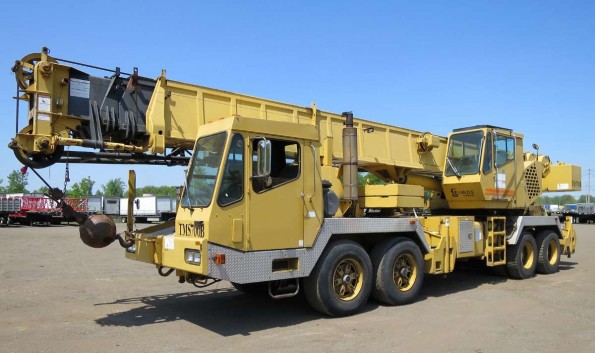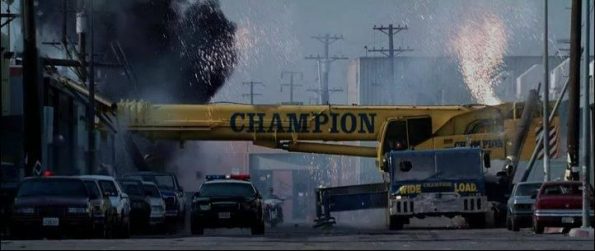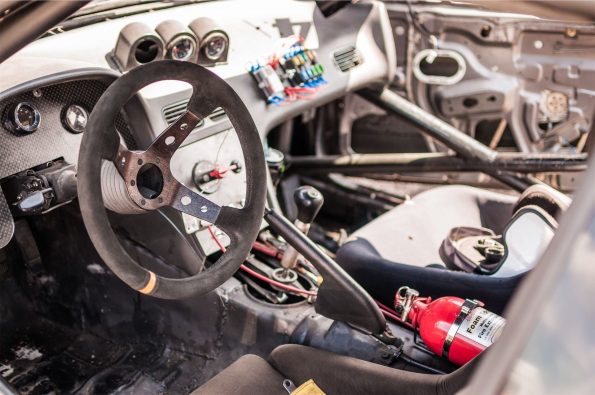Stunt driving isn’t just the flips, chases and barrel rolls you see in the movies, it also includes very precise driving that must be able to be repeated until the shot is successful. Stunt drivers often have a background in racing as this can help with high-speed car control (particularly if that background is in drifting) but it’s not essential.
What’s the stunt driver’s role on set?
A stunt driver will drive a vehicle to a precise set of instructions directed by the director. It could be a car, motorbike, tank, snowmobile or motorised couch. It’s the stunt driver’s expertise that helps make the trajectory and performance of the vehicle, plus the safety of the cast and crew, predictable.
Some stunt drivers specialise in one type of vehicle, e.g. boats or motorbikes, while others may have background experience driving heavy machinery such as wheeled cranes and dump trucks.

Would you see a crane in a chase scene?

Yep – this crane featured in Terminator 3 and would have required absolute precision driving due to its width, inherent instability and the amount of damage it had to do.
What’s your benefit to the movie as a stunt driver?
- You are cheap compared the stars: The major stars of the movie can be paid millions of dollars; you won’t be. It might be impossible to insure certain actors to do certain stunts, too.
- It can take hours to set up for one ten-second scene, so you need to get it right first time or it can be a huge cost to the movie’s budget and a big waste of time.
- Stunt drivers are aware of the physical demands of doing stunts and will be coordinated enough to handle the split-second timing required. Vehicles must often be driven faster than usual because they look slower when filmed.
- Your contribution to setting up the stunt can be invaluable – you’ll have experience for how to get the best shot, where the cameras should be positioned and perhaps how to engineer the vehicle.
- Your consistency will mean that it could be possible to switch between takes without there being a noticeable change in vehicle position,
- Vehicle insurance for some of the more expensive vehicles used on movie sets may be contingent on a stunt driver driving the vehicle (if insurance can be obtained at all).

Understanding how cars are made safe for stunts is a useful skill
What physical and personal characteristics do stunt drivers have?
- Detail-orientated: so many things can go wrong in a stunt, so they need to have micro-awareness of all the details
- Team player: stunt drivers rarely work alone. There will be a team of people preparing the car, rigging any explosives, etc. Drivers that aren’t team players don’t get hired.
- Neutral appearance: you won’t get hired as a stunt driver if you are 200kg. If you need to look 200kg, you’ll wear a fat suit. Drivers should be fit and preferably of average height.
- Calmness: stunts are dangerous and happen at high speed so it’s important to stay cool.
- Physically and mentally resilient: stunts are often done in adverse weather conditions in a hot vehicle with no air conditioning, uncomfortable seats and under additional stresses such as high g-forces or impacts
How much do stunt drivers earn?
It’s likely that you will start out earning virtually nothing until you have proved yourself competent and safe with the equipment. Experienced drivers can make a six-figure annual income.
Have good insurance because deaths and injuries do happen.
What driving skills do stunt drivers need?
It’s helpful to attend a stunt school to learn the basic skills for the vehicles you want to drive. At minimum in a car you will need to have precise high-speed control and the ability to drift (skid sideways) in both front-wheel drive and rear-wheel drive cars, do a handbrake turn and a j-turn (driving backwards then sliding the car around to drive forwards). Advanced moves include the more destructive stunts such as flips, barrel rolls, driving on two wheels and jumps.
Motorbike stunt riders must be able to do wheelies (rear and nose), jumps, burnouts, off-road riding and drifting. It would be common in a motorbike chase scene to have to deal with various street furniture, stairs, kerbs and small jumps.
How do you start your career as a stunt driver?
Getting skills and experience
- Get qualified and get experience as many vehicles as possible; the more vehicles you can drive, the more use you are on-set.
- You must be able to drive a manual vehicle.
- Learn the basics of engineering so you understand roll cages and other vehicle strengthening.
- You should know the brands and models of car – if a director asks you to get in the Charger and you don’t know what that is, stunt driving is not for you.
- Hone some specific skills, e.g. drifting, off-road racing, etc
- Know the classic chase scenes from different movies so that you can talk knowledgeably about your industry – this list of movie chase scenes is a good start.
Getting a job
- Approach existing stunt crews to see if they have any openings.
- Mix with film industry personnel.
- Make yourself a resume and demo reel (a short video of your driving scenes) and ensure that film companies are aware of you
- Look for other work that involves performance driving – this could be teaching high-performance driving courses at your local race track, working on live shows and helping choreograph stunt driving scenes.
- Do a stunt course
- Join an acting union if required.
